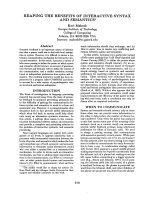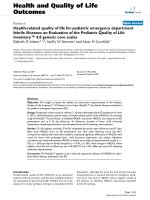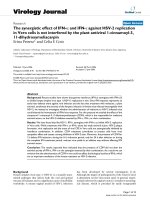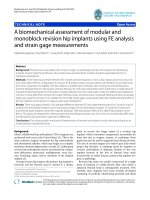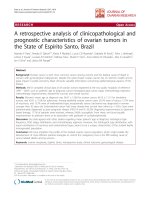Báo cáo hóa học: " Sergio Barbarossa Department of Information and Communication," pdf
Bạn đang xem bản rút gọn của tài liệu. Xem và tải ngay bản đầy đủ của tài liệu tại đây (633.82 KB, 4 trang )
EURASIP Journal on Applied Signal Processing 2004:5, 587–590
c
2004 Hindawi Publishing Corporation
Editorial
Sergio Barbarossa
Depar tment of Information and Communication, University of Rome “La Sapienza,” 00184 Rome, Italy
Email:
Constantinos Papadias
Bell Labs, Lucent Technologies, 791 Holmdel-Keyport Road, Holmdel, NJ 07733, USA
Email:
H. Vincent Poor
Department of Electrical Engineering, Pr inceton University, Princeton, NJ 08544, USA
Email:
Xiaowen Wang
Agere Systems, Allentown, PA 18109, USA
Email: xiaowe
The topic of multiple-input multiple-output (MIMO) sys-
tems is one that has attr acted a significant amount of atten-
tion in the research community over the past decade or so.
MIMO systems refer to wireless systems that are equipped
with multiple antenna elements on either side of a commu-
nication link. Propelled by the startling discovery in the mid
1990’s that the capacity of MIMO systems grows roughly
proportionally with the minimum number of antenna ele-
ments on each side of the wireless link, the field has under-
gone an explosive growth in both the academic and the in-
dustrial communities that has led to many further impor-
tant advances. These advances have brought about not only
the definition of new subareas of focused research, but also,
equally importantly, a reconsideration of older techniques
and a cross-fertilization of ideas from several other overlap-
ping fields.
One of the research areas that has both affected strongly
MIMO systems and has been equally affected by them is that
of signal processing, a s many of the developed/demonstrated
MIMO transceiver architectures are based on advanced sig-
nal processing techniques. On the transmitter side, one can
view most space-time coding/spatial multiplexing techniques
as solving a problem of space-time signal design. On the re-
ceiver side, various flavors of multiuser detectors, space-time
decoders, and related techniques for MIMO channel estima-
tion and tracking (e.g., including blind/semiblind process-
ing) are also typically derived in a signal processing frame-
work.
More recent research on MIMO systems has started to
focus on new areas of interest. At the link level, such ar-
eas are the handling of cochannel (e.g., in-cell and out-of-
cell) interference; the development of precoding techniques
at the transmitter to preempt adverse channel effects; and the
design and use of efficient receiver-to-transmitter feedback
mechanisms to improve the link throughput. In parallel,
many studies have focused on the application of such MIMO
techniques to specific transmission formats (dictated by dif-
ferent air interfaces) such as CDMA, OFDM, and so forth.
Moving up the protocol stack, the interaction of MIMO tech-
niques with MAC layer procedures such as adaptive retrans-
mission and scheduling is an area that has started producing
important know-how, especially regarding the suitability of
MIMO techniques in high-speed data systems. Moving be-
yond wireless links, architecting an entire wireless network
that uses MIMO connections poses a number of important
questions, both at a fundamental level (e.g., MIMO network
capacity) and at a practical level (e.g., MIMO network de-
sign).
With all of the above in mind, this special issue aims at
giving a well-rounded snapshot of recent advances that cover
most of these topics, with a special emphasis on signal pro-
cessing methodologies as a design tool. As progress in the
field is both rapidly emerging and voluminous, it has clearly
not been our intent to provide an exhaustive coverage of all
MIMO topics but rather a good selection of recent studies
that are indicative of the progress in the field.
588 EURASIP Journal on Applied Signal Processing
The papers included in this sp ecial issue address a broad
range of issues arising in the development and application of
MIMO techniques. These contributions range from general
space-time coding and processing techniques and analytical
methodologies to specific implementation issues arising in
particular wireless standards and environments and to fun-
damentals of wireless MIMO networks. Among other topics,
they touch upon the areas of transmitter and receiver design,
blind and training-based techniques, link-level and system-
level studies, open- and closed-loop systems, physical layer
and higher layer issues, and w ireless LAN and cellular appli-
cations.
The specific contributions of the papers in this issue are
summarized in the following paragraphs.
Invited paper
In their invited paper, Jafar, Foschini, and Goldsmith present
an in-depth analysis of the so-called “PhantomNet” wireless
network concept. In such a network, the best possible ser-
vice is provided to new users joining the network without
affecting existing users. The problem is addressed in its full
generality, that is, assuming multiple cells, users, and anten-
nas, and results are obtained for both uplink and downlink
communication. Optimality is sought in terms of the mul-
tiuser capacity region. This leads to a high degree of gen-
erality of the presented results and solutions. Furthermore,
despite the inherent differences between the two directions
of communication (and the resulting differences between
the corresponding solutions), the authors demonstrate a re-
markable symmetry between the uplink and downlink prob-
lems.
Channel estimation and multiuser detection
in MIMO systems
In the first paper of this section, J. Du and Y. Li study the
problem of channel estimation for D-BLAST OFDM sys-
tems. The authors propose a layerwise channel estimation al-
gorithm that takes advantage of the D-BLAST structure. Fur-
ther performance improvements are realized by introducing
a subspace tracking scheme.
In the next paper, Buzzi, Grossi, and Lops study the
problem of blind multiuser detection in asynchronous DS-
CDMA systems equipped with multiple antennas. Several
novel blind schemes are proposed and their p erformance is
evaluated, showing their multiple access interference sup-
pression capability, despite the absence of channel state in-
formation.
Another blind detection scheme that is specifical ly tai-
lored to space-time differentially encoded systems is pre-
sented in the paper by Zhang and Ilow. Their proposed re-
ceiver algorithm is based on constant modulus characteristics
of signaling and it is suitable for a rich multipath environ-
ment. The scheme requires no channel estimation and can
work with small numbers of signal samples.
In their paper, Y. Du and Chan examine a technique for
speeding up the search for an optimal multiuser detection
solution using a genetic algorithm. The authors first study
the objective function of the genetic algorithms. Then they
propose two detectors to generate the seed chromosome of
the initial population. Their results show that the proposed
scheme not only reduces the computational complexity of
finding the detector, but also improves performance.
MIMO systems, space-time coding, and beamforming
In the first paper of this section, C. Li and Xiaodong Wang
compare the performance of three well-known MIMO tech-
niques: BLAST, space-time block coding (STBC), and lin-
ear precoding/coding (i.e., beamforming) in the context of
WCDMA. The authors study the signal-to-noise properties
analytically, and the bit error rate performance via simu-
lations. The y also consider a subspace method for imple-
menting the linear precoding method (which requires chan-
nel knowledge at the transmitter). The authors evaluate the
trade-offs between BLAST and STBC in terms of data-rate
and diversity in this situation (see also the following pa-
per in this section) and demonstrate that subspace-based
beamforming can be effectively realized in WCDMA sys-
tems.
In the next paper, Mecklenbr
¨
auker and Rupp consider
a new STBC scheme that extends the well-known Alam-
outi codes to the situation in which the number of trans-
mit antennas is an arbitrary power of two. Further solutions
for arbitrary even numbers of transmit antennas are also
presented, which offer improved orthogonalization proper-
ties while preserving high diversity. The authors also con-
sider schemes that trade off the properties of Alamouti and
BLAST-type systems (see also Li’s and Wang’s paper above)
to achieve a continuous trade-off between quality of service
and data rate. The appropriate trade-off can b e selected using
only the number of transmit antennas. Implications of these
techniques for UMTS are also discussed.
MIMO systems and interference
In his paper, Blum studies the problem of maximum system
mutual information in MIMO systems that employ antenna
selection in the presence of interference. This leads to opti-
mal signaling covariance matrices for the interesting case of
limited channel feedback required for antenna selection.
The paper by Song and Blostein studies the effect of col-
ored space-time interference on MIMO systems, emphasiz-
ing the problems of channel estimation, data detection, and
interference correlation estimation. The focus is on the case
of one dominant interferer and the quantification of its im-
pact on the performance of a generalized BLAST ordered
data detection algorithm. The authors show that exploiting
the interference’s spatio-temporal nature can result in impor-
tant gains.
MIMO techniques in current/emerging air interfaces
In the first paper of this section, J. Liu and J. Li study some
practical issues arising in the application of MIMO OFDM
Editorial 589
to high-rate wireless LAN systems. The authors propose sig-
naling and corresponding synchronization, channel estima-
tion, and detection schemes that are backward compatible
with the existing 802.11a standard. They also propose the
use of a BLAST-type data transmission scheme and a sim-
ple LS-based soft detector to reduce the complexity of the
receiver.
In the next paper, Hansen, Affes, and Mermelstein revisit
the problem of multiuser detection in CDMA networks. The
authors apply an interference subspace rejection technique
to the downlink of networks in which the spreading factors
or modulation used by the interferer may not be known. The
schemes proposed in the paper require no prior knowledge
of these factors. A new code allocation scheme is also pro-
posed to reduce the complexity of the proposed interference
cancellation schemes.
The paper by Gonz
´
alez-L
´
opez, M
´
ıguez, and Castedo pre-
sents a maximum likelihood channel estimation scheme that
is suitable for turbo equalization in a space-time coded sys-
tem. The authors apply their scheme to GSM-based trans-
mission in a subway tunnel. Their experiment shows a sig-
nificant reduction in the required training sequence length.
In the final paper of this section, Leus, Petr
´
e, and Moonen
propose novel transmit diversity and corresponding space-
time chip equalization techniques for DS-CDMA systems.
Their proposed scheme is shown to achieve both maximal
antenna diversity and maximal multipath diversity.
Resource allocation and feedback in multiple
antenna systems
In the first paper of this section, Han, Farrokhi, and K. J. Ray
Liu revisit the problem of jointly optimizing power control
and beamforming to minimize the cochannel interference.
The authors optimize the bit error rate directly in calculating
the power and beamforming vector. Both the power control
and beamforming algorithms are updated iteratively and are
shown to converge.
In their paper, Chung, Lozano, Huang, Sutivong, and
Cioffi study closed-loop MIMO systems. In order to achieve
the closed-loop capacity, the authors propose to use a low
rate feedback channel to provide rate and power informa-
tion to the transmitter. Two joint rate and power allocation
schemes are proposed and studied by the authors. Their re-
sults show that the performance loss due to the quantization
of power is marginal, and that the MIMO system demon-
strates an average rate close to capacity with the low-rate
feedback channel and strong coding scheme.
Higher layer issues in MIMO systems
In the final paper of the special issue, Zheng, Lozano, and
Haleem propose an ARQ scheme based on the BLAST sys-
tem. The authors suggest the use of separate ARQ for each
layer of the BLAST transmission. This multiple ARQ struc-
ture not only improves the throughput, but also facilitates
the interference cancellation.
We believe that the included papers present an excellent
sampling of state-of-the-art research in the field of MIMO
communications and signal processing. We would like to
thank all of the authors for their timely contributions and
we anticipate that these papers will make this special issue a
useful reference that will act as a catalyst for further exciting
research in the field of MIMO systems.
Sergio Barbarossa
Constantinos Papadias
H. Vincent Poor
Xiaowen Wang
Sergio Barbarossa graduated in 1984 and received his Ph.D. de-
gree in 1989 from the University of Rome “La Sapienza,” Italy.
From 1984 to 1986, he was a Radar System Engineer at Selenia.
In 1988, he was at the Environmental Research Institute of Michi-
gan (ERIM), Ann Arbor, USA. From 1989 to 1991, he was with the
University of Perugia and in 1991, he joined the University of Rome
“La Sapienza,” where he is now a Full Professor. Since 1997, he is a
Member of the IEEE Signal Processing for Communications Tech-
nical Committee. From 1998 to 2000, he served as an Associate Ed-
itor for the IEEE Transactions on Signal Processing. He coauthored
a paper that received the 2000 IEEE Best Paper Award in the Sig-
nal Processing for Communications area. He has been the General
Chairman of the SPAWC 2003 (Rome, 2003). He has held visiting
positions at the University of Virginia in 1995 and 1997, Univer-
sity of Minnesota in 1999, and Polytechnic University of Catalunya,
Spain, in 2002. He is the author of a research monograph on Mul-
tiple Antenna Systems (Artech House, 2004). He is the scientific
responsible, for his University, of two IST European projects on
space-time coding and multihop networks. His current research in-
terests lie in the area of self-organizing networks, random graphs,
and distributed space-time coding.
Constantinos Papadias was born in
Athens, Greece, in 1969. He received his
Diploma of electr ical engineering from the
National Technical University of Athens
(NTUA) in 1991 and the Ph.D. degree in
signal processing (highest honors) from
the Ecole Nationale Sup
´
erieure des T
´
el
´
e-
communications (ENST), Paris, France, in
1995. From 1992 to 1995, he was Teaching
and Research Assistant at the Mobile
Communications Department, Eur
´
ecom, France. From 1995 to
1997, he was a Postdoctoral Researcher at Stanford University’s
Smart Antennas Research Group. In November 1997, he joined the
Wireless Research Laboratory of Bell Labs, Lucent Technologies,
Holmdel, NJ, as member of technical staff. He is now Technical
Manager in Global Wireless Systems Research Department, Bell
Lab’s, overseeing several research projects, with an emphasis on
space-time and MIMO systems. He has authored several papers,
patents, and standards contributions on these topics and he
recently received the IEEE Signal Processing Society’s 2003 Young
Author Best Paper Award. He is a Member of the Signal Processing
for Communications Technical Committee of the IEEE Signal
Processing Society and Associate Editor for the IEEE Transactions
on Signal Processing. Dr. Papadias is a Senior Member of IEEE and
a Member of the Technical Chamber of Greece.
590 EURASIP Journal on Applied Signal Processing
H. Vincent Poor received the Ph.D. degree
in EECS from Princeton University in 1977.
From 1977 until 1990, he was at the Univer-
sity of Illinois at Urbana-Champaign. Since
1990, he has been at Princeton University,
where he is the George Van Ness Lothrop
Professor in Engineering. Dr. Poor’s re-
search interests are in the areas of wireless
networks, advanced signal processing, and
related fields. He is the author of more than
500 publications in these areas, including the recent book Wireless
Communication Systems: Advanced Techniques for Signal Reception
(Prentice-Hall, Upper Saddle River, NJ, 2004). Dr. Poor is a Mem-
ber of the U. S. National Academy of Engineering, and is a Fellow of
the IEEE, the Institute of Mathematical Statistics, and other orga-
nizations. In 1990, he served as President of the IEEE Information
Theory Society, and in 1991–1992, he was a Member of the IEEE
Board of Directors. Among his recent honors are the IEEE Grad-
uate Teaching Award in 2001, the Joint Paper Award of the IEEE
Communications and Information Theory Societies in 2001, the
NSF Director’s Award for Distinguished Teaching Scholars in 2002,
and a Guggenheim Fellowship in 2002–2003.
Xiaowen Wang received her B.S. degree
from the Department of Electronics En-
gineering, Tsinghua University, Beijing,
China in 1993, and the M.S. and Ph.D.
degrees from the Department of Electrical
and Computer Engineering, University of
Maryland, College Park, MD, in 1999 and
2000, respectively. From 1993 to 1996, Dr.
Wang was a Teaching Assistant at Tsinghua
University, Beijing, China. From 1996 to
2000, she was a Research Assistant at the University of Maryland,
College Park, MD. Since 2000, she has been with the Wireless Sys-
tems Research Department, Agere Systems (formerly Bell Labs,
Lucent Technologies, Microelectronics). Her research interests in-
clude adaptive digital signal processing, wireless communications,
and networking . Dr. Wang was ranked the first among the class of
Department of Electronics Engineering for her B.S. degree from
Tsinghua University in 1993, and was the recipient of the Graduate
School Fellowship from University of Maryland.

